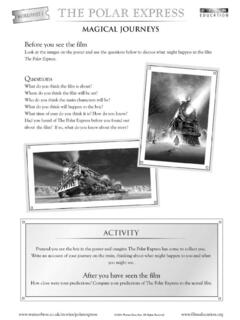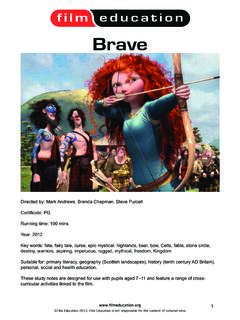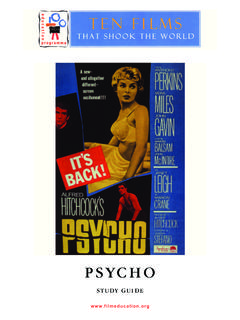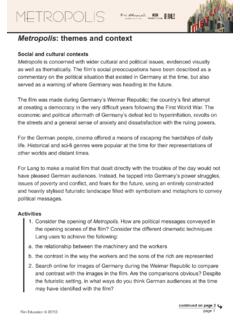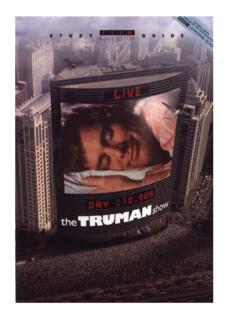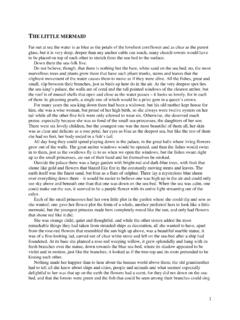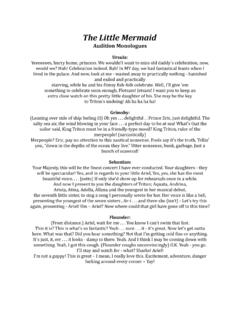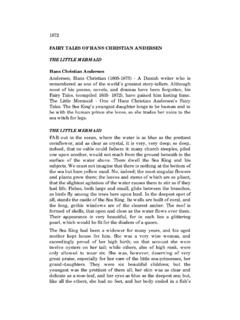Transcription of STUDY GUIDE - Film Education
1 STUDYGUIDETEACHERS NOTESA imed at primary pupils, the ideas in this STUDY GUIDE are intended as starting points for a cross-curricular projecton the film The little mermaid at Key Stages 1 and 2. Many curriculum areas are covered although the focusis on English and activities seek to complement and extend the pleasure the children will have derived from a visit to the cinemaand from watching the BBC programme (broadcast 10, 17 April, 1 May ) whilst at the same time meetingsome of the requirements of the National Curriculum and Scottish tables provided can be used for planning and record keeping. The reference page at the back has a fishy cover up the text and photocopy to create special sheets for the children to write up their SYNOPSISA riel, a bubbly young mermaid longs to be part of the human world. She boldy goes where no mermaid has evergone before to land the prince of her dreams.
2 Ignoring her father, King Triton, and her guardian crab, Sebastian,the determined mermaid strikes a deal with a devious sea witch but quickly discovers that there s a big catch .UK release date: July 17, 1998. Cert: U. Running time: 79 mins. Distributed by: Buena Vista International (UK) CHRISTIAN ANDERSENFrom the time of the Greeks to the present day there have been tales of mermaids. Long ago mermaidswere known as morgans and were thought to be very dangerous. They were said to live in wonderfulcastles under the sea. Hans Christian Andersen was one of the first writers to change this image of mermaidswhen he wrote The little mermaid .Find out which of the following fairy stories was written by HansChristian Andersen and underline them. Put a tick next to the stories youhave read. Try and find out about Hans Christian Andersen himself - where he lived, whenhe was born Emperor s New ClothesSnow White And The Seven DwarvesCinderellaThe Ugly DucklingThe Snow QueenThe Red ShoesSleeping BeautyThe Princess And The PeaThis is a picture of a statue of The LittleMermaid in Copenhagen at the entrance to theharbour.
3 It is a bronze figure of a mermaid lookingout to sea. It was put there to commemorate thelife and work of Hans Christian your own model of The little mermaid .Use clay for the body and find a large stonefor her to sit Disney was a great fan of Hans ChristianAndersen s work. How many of the fairy talesin the list have been made into films? Why doyou think fairy tales are so suitable foranimated films?Fairy tales usually have a happy ending and at the end of the film we see Ariel and Prince Eric gettingmarried. The ending of the story written by Hans Christian Andersen is quite out what the ending by Hans Christian Andersen is. Why do youthink the filmmakers changed the ending? Which ending do you preferand why? Tony Stone Images2 MERMAIDS AROUND THE WORLDT here have been many different beliefs aboutmermaids around the world.
4 In Ireland, some peopleused to think that on St Patrick s Day old women wereturned into mermaids and thrown into the idea was that if humans and mermaids hadchildren together, their children would find it hard tosleep at night and were haunted by the sound of the sea. It was widely believed that if you looked at a mermaidyou would have bad luck. If however you managed toget something that belonged to a mermaid then youwould share their magic are some of the names that have been given to mermaids throughout the centuries in differentparts of the world. Some of these names are from stories and films, some are old and some are one do you like best?Find out about one of the mermaids mentioned above ormake up a mermaid myth of your own. Plan out your storycarefully before you begin. Write out your plan on the mermaid Story Plan worksheeton the next CaribbeanMama AloEnglandMirandaScotlandSelkieFranceUdi ne and MelusinaGermanyNixeGreeceArtemisHollandM ensjeLaplandAkkrivaRussiaRusalkaJavaLoro KidulHollywoodArielMary Evans Picture Library3 mermaid STORY PLANCHARACTERS(Who is going to be in your story?)
5 BEGINNING(How is it going to start?)MIDDLE(What is going to happen in your story?)END(How is it going to end?)SETTING(Where is it going to happen?)SEA CREATURESThis is a fact file about the octopus - reproduced from Disney s Story Studio THE little mermaid (more details of this and Disney s Print Studio can be found on the references page at the back of theguide). Read it through - you will probably beamazed at how much there is to know!Choose another sea creatureshown in the film. Find out asmuch as you can about it. Look in referencebooks, on the Internet etc. Create your own factfile on your sea creature - make it as funny andinteresting as possible. Remember to draw apicture of your creature at the top ofthe ACTIVITYTURN YOUR CLASSROOM INTO ARIEL S UNDERWATER WORLD!Now that your pupils imaginations are bubbling with marine images - why not set them a challenge?
6 Your group can take ideasfrom one (or all) of the following or maybe they d prefer to come up with something entirely original. DISPLAY IDEASTurn one corner of the classroom into a coral reef. The brighterthe colours the better! Decorate it with paintings, drawings ormodels of algae, tropical fish and plants. Turn another corner into a shipwreck scene, with sunkentreasure and relics from an ancient ship. You could find out aboutfamous sea-farers from the past and write a diary of a day in thelife of a shell patterns out of and make some diving gear of the you are very brave, you could make a life sized Ariel out of wiremesh and papier m ch !WHO EATS WHO? FOOD CHAINSE very living thing needs to eat to stay alive. This is the same for things that live in the sea. Limpets eatalgae, crabs eat limpets and seals eat crabs. This is called a food chain, or a food web.
7 Cut out the creatures shown on the following page and stick them onto card. Colourthem in. On a large sheet of paper, stick your pictures down and draw arrows toshow who is eaten by who. This is a FOOD WEB. Use reference books to help you. Remember, all foodchains start with a plant. With a partner or in small groups, talk about what would happen to your foodweb if the following things happened:the fish were poisoned?the seals were hunted and made extinct (wiped out)?there were too many shrimp?the seaweed was coated by oil from an oil slick?too much fishing was going on and most of the cod disappeared?How would this change things?Pretend that you and yourpartner(s) are reporters for anewspaper or a televisionprogramme. It s your job to telleveryone about the dangers ofpollution in the sea and how itaffects the food , write a newsbulletin (no more than 150words) on the problems thatface British sea life.
8 Whenyou have written yourbulletin, draw pictures to show the problems. You could present your final copy either as a newspaperarticle, or you could record it as aradio or television though, it s your job totry and stop people frompolluting our luck! 67 WHO EATS WHO? FOOD CHAINS IISEAWEEDCODPLANKTONLIMPETSHRIMPCRABSEAL CORMORANTANIMATIONA nimation means making drawings move. It can take a very long time to do this. It took four hundredpeople three years to make The little mermaid and in that time over one million drawings were people who draw the pictures are called animators. They often spend a long time finding out aboutthe subject they are going to draw. As part of the preparations for the film A little mermaid , a largeaquarium was brought to the design studio so that the animators could watch and sketch the fish.
9 Theyalso studied pictures from reference books and the box below write down the names of all of the sea creatures that you seein the out as much as you can about one of these sea creatures by looking in referencebooks and on the Internet. Your information should include what the creature lookslike, where it lives, what it eats and if it is eaten by any other creatures. Try to include a picturetoo. The information that you collect could form part of an exciting wall display or reference bookfor other producer of the filmhas decided to include thesea creature that you researched as one of thecharacters in the film. You have been asked to drawa cartoon sketch and fill in the details in the charton the next A CHARACTERMAGICAL MUSIC FROM THE FILM THE little MERMAIDWhen originally released in 1989, the music from The little mermaid won many awards.
10 Now singersPeter Andre and Shaggy have recorded their own versions of Kiss the Girl and Under the Sea to coincidewith the re-release of the film. No doubt you will soon be familiar with these new versions, due to hitthe charts in July!Sebastian the crab comes from the Caribbean. There is an island in the Caribbean called Trinidad. A veryunusual percussion instrument comes from the Caribbean which is called the steel drum. This steel drumis used in the song Under the Sea . Using reference books or the Internet find out about the steel drum. Whatis it made from? How is it made? How is it played? Draw people playingthe steel drums. Under the Sea has a swinging rhythm called calypso. Find out whatcalypso music is and where it comes from. Write down any other calypsosongs or pieces of music that you know of. You could even try to compose your you see the film The little mermaid , listen carefully to the song Kiss the Girl.
